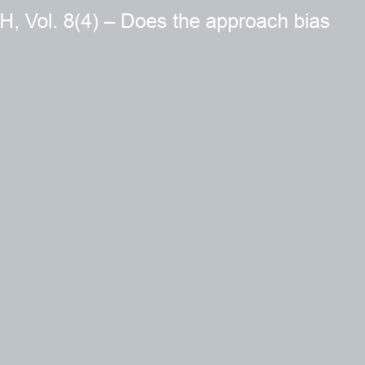When people use drugs for a prolonged period of time, they can develop an automatic tendency to approach rather than avoid drug-related cues – a trait named approach bias (Mogg & Bradley, 2005). This week’s STASH reviews a Dutch study that investigates if the approach bias toward cannabis-related stimuli predicts future escalation of cannabis use among heavy cannabis users (Cousijn, Goudriaan, & Wiers, 2011).
Method
- Participants were 32 heavy cannabis users (34% female) and 41 non-using controls (37% female) aged 18 – 25 recruited through advertisements on the Internet and in the coffee-shops in Amsterdam1.
- Heavy cannabis use was defined as use on 10 or more days during the last month and 240 days during the past 2 years.
- Participants who met two criteria—fewer than 50 life-time use occasions and no use during the last year—were considered to be non-users.
- People who did not meet these definitions were not eligible to participate in the study. The authors do not report the number of these people.
- Researchers used an Approach Avoidance Task to assess whether participants had an approach bias towards cannabis-related images. Participants viewed slightly rotated cannabis and neutral images and pulled or pushed a joystick as quickly as they could to indicate the rotation direction (i.e., clockwise or counter-clockwise)1. Pulling the joystick increased the image size and pushing the joystick out decreased the image size, emphasizing the sense of approach or avoidance, respectively.
- The researcher calculated median approach and avoidance response times (RTs) for cannabis-related and neutral images. Next, they calculated the approach bias for each image category by subtracting the median approach RT from median avoid RT. Positive scores indicate an approach bias (i.e., quicker approach responses).
- Researchers assessed cannabis use and related problems (Cannabis Use Disorder Identification Test, Adamson, & Sellman, 2003) and other measures during the baseline and 6-month follow-up sessions. They achieved a 97% 6-month follow-up rate.
Results
- The researchers conducted a 2 (user status) X 2 (image type) ANOVA test. Table 1 demonstrated significant (F (1,69) = 4.53; p < .05) image-type/cannabis use interaction effect on the approach bias. Then, the researchers conducted follow-up t-tests to indicate the simple effects of user type within each level of image category. Heavy cannabis users demonstrated a larger approach bias toward cannabis-related images than controls (t [69] = 2.33, p< .03, d = 0.55). Heavy cannabis users and controls did not differ on approach bias toward neutral images (p = .91).
|
|
Cannabis image |
Neutral image |
|
Heavy cannabis users |
803.7 (80.1) | 827.5 (79.7) |
| Nonusers | 831.4 (72.5) | 837.3 (75.1) |
Figure. Mean (sd) approach bias for cannabis-related and neutral images.
- Among heavy cannabis users, the approach bias toward cannabis-related images was positively correlated with weekly cannabis use at 6-month follow-up (R =.42, p<.03).
- The researchers attempted to predict change in weekly cannabis use (in grams) from baseline to 6-month follow-up. Baseline cannabis use variables explained 63% of the variance in change in use. The approach bias toward cannabis-related images explained an additional 13% of the variance (F change [1,20] = 10.65, p<. 01). Cannabis users with a stronger approach bias toward cannabis-related images at baseline were more likely to escalate their cannabis use.
- The approach bias did not predict changes in cannabis-related problems and dependence.
Limitations
- Limited sample size combined with the convenience sample might limit the generalizability of the findings. It also is unclear whether the same patterns would hold in a region that is characterized by less tolerant cannabis use policies.
- A greater proportion of cannabis users than non-users were tobacco smokers. Tobacco use might have contributed to the approach bias among cannabis users.
Conclusions
The study demonstrated that motivational shifts, as reflected in approach-related movements, are related to cannabis use. The strength of the initial approach bias contributed to the predicted of an escalation in cannabis use. This task might be useful in providing personal feedback to individuals wishing to maintain or cut back on their cannabis use. However, it is important to note that escalating use did not correspond to cannabis-related problems and dependence. Therefore, based on the results of this study, we cannot conclude that approach bias toward cannabis-related cues predicts the cannabis induced problems.
-Julia Braverman
What do you think? Please use the comment link below to provide feedback on this article.
References
Adamson, S. J., & Sellman, J. D. (2003). A prototype screening instrument for cannabis use disorder: the Cannabis Use Disorders Identification Test (CUDIT) in an alcohol- dependent clinical sample. Drug Alcohol Review, 22, 309 – 315.
Cousijn, J., Goudriaan, A. E., & Wiers, R. W. (2011). Reaching out toward cannabis: Approach- bias in heavy cannabis users predicts changes in cannabis use. Addiction, 106, 1667 – 1674.
Heishman S. J., Evans, R.J., Singleton, E. G., Levin, K. H., Copersino M. L., Gorelick, D. A. (2009). Reliability and validity of a short form of the Marijuana Craving Questionnaire.Drug alcohol Dependence, 102, 35 – 40.
Mogg, K. & Bradley, F. M. (2005). Attentional and approach biases for smoking cues in smokers: An investigation of copeting theoretical views of addiction. Psychopharmacology, 180, 333 – 341.




